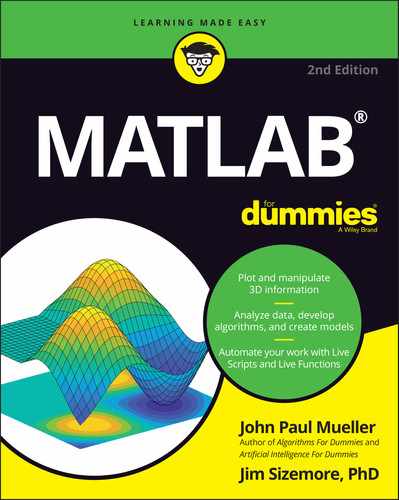Appendix B
MATLAB’s Plotting Routines
The tables in this appendix, B-1 through B-5, list each of the plotting routines in MATLAB with a brief description and an example. To save space, some entries show a single encompassing example for multiple commands. An example may also use an ellipsis (…) to show the continuation of a pattern. To assist you, the code includes several functions to generate test matrices, for example, rand(), magic(), peaks(), cylinder(), ellipsoid(), and sphere(). It’s also important to note that MATLAB is always changing and that some functions, like ezpolar(), are eventually going to go away. After all, many of the other ez* functions have retired and are now sipping beverages on a sandy beach on a tropical island.
TABLE B-1 Basic Plotting Routines
Routine |
Description |
Example |
|---|---|---|
|
Just like |
|
|
Plots data passed in by vectors |
|
|
Plots data where |
|
|
Like |
|
|
Plots the expression or function |
|
|
Plots data on a log scale on both x- and y-axes — |
|
|
X-axis data is on a log scale and the y-axis is on a linear scale — |
|
|
Y-axis data is on a log scale and x-axis linear — |
|
TABLE B-2 Beyond Basics
Routine |
Description |
Example |
|---|---|---|
|
Acts just like |
|
|
Creates a standard bar chart that can handle both grouping and stacking |
|
|
Just like |
|
|
Adds a little 3D pizazz to a standard bar chart |
|
|
Creates a 3D horizontal bar chart |
|
|
Like |
|
|
Creates a |
|
|
Fills polygons (vector inputs define vertices) with the specified color |
|
|
Creates a standard pie chart |
|
|
Adds some 3D pizazz to |
|
|
Creates a polar plot like |
|
TABLE B-3 Statistical Plotting Routines
Routine |
Description |
Example |
|---|---|---|
|
Like |
|
|
Creates a histogram — a bar chart showing the frequency of occurrence of data vs. value. These two routines handle the bins differently |
|
|
Plots |
|
|
Like |
|
|
Related to |
|
|
Like |
|
|
Like |
|
|
A cross between |
|
|
A bar chart arranged with the highest bars first |
|
|
A |
|
|
A |
|
TABLE B-4 3D Graphics
Routine |
Description |
Example |
|---|---|---|
|
Creates a contour plot with matrix arguments |
|
|
Same as |
|
|
Same as |
|
|
Creates a wireframe mesh surface |
|
|
Wireframe mesh with contour |
|
|
Wireframe mesh with a curtain around the plot |
|
|
Shows values of the matrix as colors |
|
|
Same as |
|
|
Creates a filled surface |
|
|
Same as |
|
|
Like |
|
|
Plots the function as a contour |
|
|
Like |
|
|
Plots the function as a mesh |
|
|
Plots a series of three functions expressing x-, y-, and z-axes as a parametric curve |
|
|
Plots the function as a 3D surface |
|
|
Like |
|
|
Like |
|
|
Stem plot of 3D data |
|
|
Creates surface plot with normal vectors |
|
TABLE B-5 Vector Fields
Routine |
Description |
Example |
|---|---|---|
|
Like |
|
|
Like |
|
|
Like |
|
|
Like streamline, but plots tubes (cylindrical 3D flow lines) |
|
|
Similar to |
|
|
Works like |
|
|
Plots line from the vector field; the example plots 2D |
